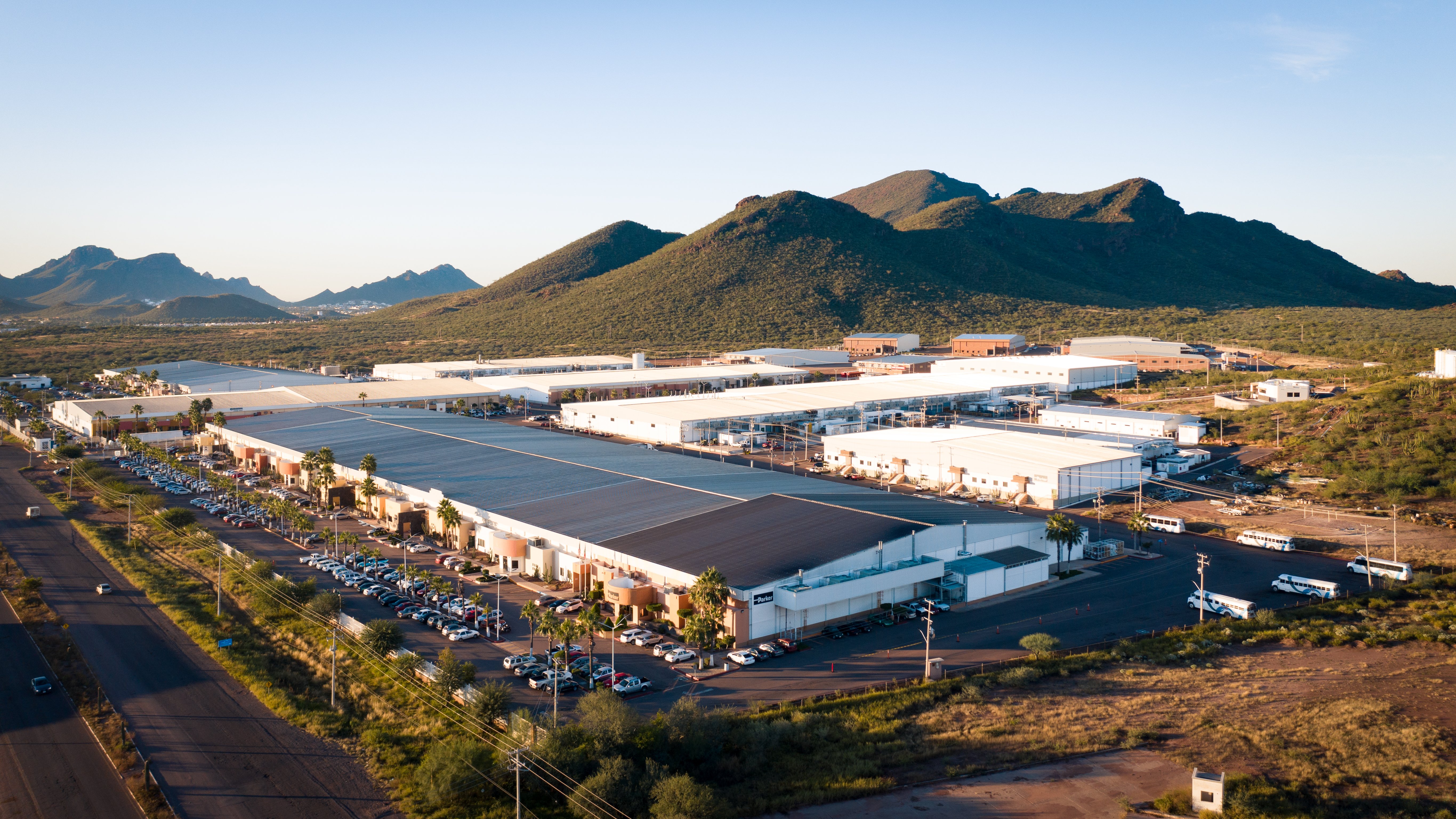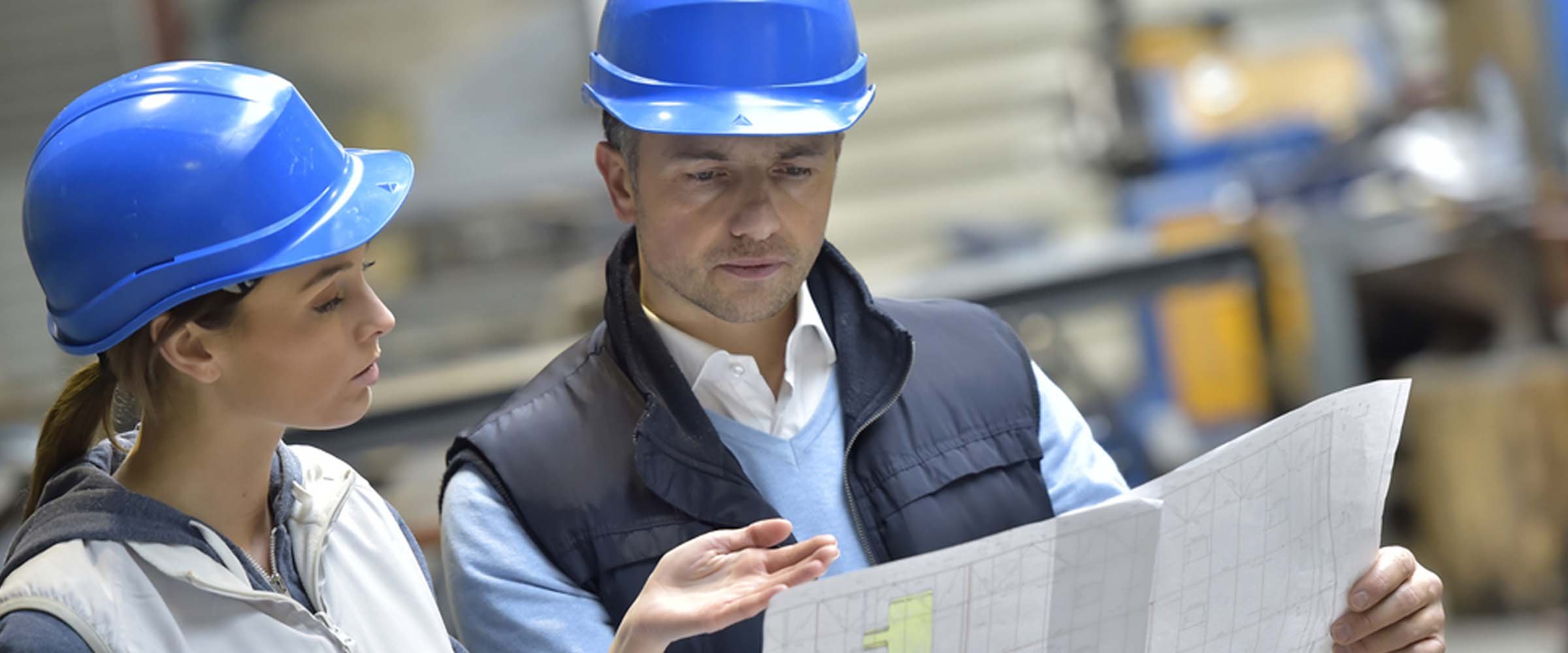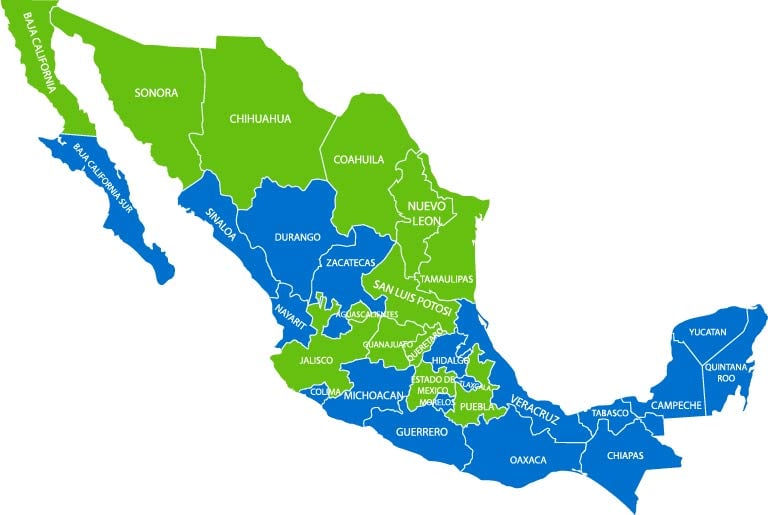Mexico has always been a hot spot for FDI, because foreign businessmen have good reasons to choose here to increase their global distribution network. Since 1999, more than 13000 companies have enjoyed the benefits of building factories in Mexico.
Now, more and more companies choose to invest in Mexico. These companies have also attracted partners related to their production supply chain and strengthened the existing operational infrastructure of Mexico's major industries. In addition, more and more large enterprises recognize the advantages of regional economy and concentrate their factories in the low-cost central area near the largest market. These advantages have greatly increased Mexico's attractiveness.
The practice results of numerous enterprises have proved that manufacturers can enter the "waiting for business" state more quickly and directly in Mexico. If your company is considering investing in Mexico, this article will provide you with all the information you need to know about the due diligence of your investment project.
Advantages of building factories in Mexico
Roca Fuerte Industrial Park in Mexico where aerospace companies go to experience the benefits of manufacturing in Mexico
There are many advantages for foreign businessmen who want to expand their manufacturing territory in Mexico. Here are some of the main advantages of building a plant in Mexico:
1. Government incentives
The federal government of Mexico has been strongly supporting foreign businessmen to build factories in Mexico. In 2018, Mexico's manufacturing revenues accounted for 17% of GDP. One of the main forms of incentive measures introduced by the government is the tariff relief measures under the IMMEX project. Through this project, if the manufacturer exports the goods within the specified time, it can "temporarily" import the production raw materials and production equipment without paying the tariff and 16% value-added tax.
Enterprises can register under the IMMEX project and obtain value-added tax (IVA) certification, so as to greatly reduce costs. One of the most efficient is the maquiladora project in Mexico. Manufacturers can conduct business activities under the legal framework of shell service providers registered under the IMMEX project. In this way, manufacturers can simplify the cumbersome regulatory process and reduce the tax burden. In some cases, you can start a new company in just 30 days.
2. Connect with the international market
It is not surprising that the United States is Mexico's largest trading partner because of the border between the two countries. Of Mexico's exports, 76.5% went to the United States. Considering the cost-effective transportation costs, if the company's target market is the United States, it is likely to choose to build a factory in Mexico to do business. Let's make a comparison: it costs about 1800 US dollars to transport a 40 foot container from Mexico to the United States in a week; it takes 3-5 weeks to transport a 40 foot container from China to the United States, and it costs about 4300 US dollars (the freight will fluctuate greatly according to the change of market supply and demand. The data in this paper is for reference only). Mexico has a number of deep-water ports, which can reach the Atlantic and Pacific Ocean, as well as railways, international airports and usmca (formerly NAFTA) highways directly to Canada. Developed transportation network makes free trade possible in North America.
In addition to the direct free trade with the United States, Mexico is a reliable choice for investors around the world. In 2018, Mexico exported $450.9 billion worth of products. Mexico has more free trade agreements (FTA) than any other country in the world, and has established trade partnership with more than 50 countries in Europe, South America and Africa. These agreements reduce trade barriers such as tariffs and import quotas, and build strong cooperation with other countries through the exchange of goods and services.
In addition, in many industries, trade centers have been established in many regional markets, and the trend of industrial regionalization has gradually expanded. Trade between manufacturers around the world and China has been affected by factors such as US Tariffs and the outbreak of the new coronavirus. Manufacturers are aware that a decentralized manufacturing business is more flexible and less risky than a single location.
3. The cost of skilled labor
The low cost of skilled labor in Mexico is one of the main reasons why manufacturers choose to build factories here. According to the cost of living in different places, the average manufacturing worker's hourly salary in Mexico ranges from $2.4 to $3.04, while that in the United States ranges from $16.07 to $25.98. Although the usmca has issued relevant regulations to require employers to raise workers' wages, experts predict that workers' wages will be raised to the required level step by step in decades. Experts also predict that wage increases will eventually help Mexican employers retain more skilled employees and improve overall manufacturing efficiency.
Finding well-trained workers to complete complex production tasks is more important than reducing costs. This is especially true in industrial clusters. Manufacturing plays an important role in the national economy, so there are many training programs for manufacturers in Mexico. Many of the portfolio projects can provide practical technical training.
Major manufacturing industries in Mexico
Medical Device Manufacturing Employees in Mexico
It is not difficult for manufacturing enterprises to operate in Mexico and obtain corresponding profits. Manufacturers in some industries will benefit more from a more centralized supply chain. Industrial cluster can help enterprises improve the efficiency of supply chain, and obtain more powerful training resources, and help local labor force to engage in related work for a long time. Specifically, five industries have attracted supporting manufacturers to concentrate their strong supply chains in Mexico.
1. Aerospace manufacturing
Aerospace manufacturing accounts for nearly half of Mexico's foreign direct investment. There are about 300 aerospace manufacturing companies operating in the industrial clusters in cretaro, Sonora, Chihuahua, new Leon and Baja California. This includes OEMs and tier 1, tier 2 and Tier 3 suppliers. Kraitaro has the largest aerospace industry cluster and is supported by universities in partnership with Bombardier.
2. Automobile manufacturing
Mexico's automobile manufacturing industry has a history of over a century, and it is the fourth largest exporter of auto parts in the world. Among the total vehicle imports from the United States, Mexico accounts for the highest proportion. So automobile manufacturing is one of the most important industries in Mexico. There are 10 OEMs operating in Mexico and they have been working with supplier networks at all levels to improve productivity and export capabilities. Mexico's automobile manufacturers are all over the country, but mainly concentrated in Coahuila, San Luis portosi, Baja California, Sonora, new Leon, cretaro, halisco and Guanajuato. Automotive manufacturing companies in Mexico have established a presence in every corner of the country, but are primarily clustered around Coahuila, San Luis Potosí, Baja California, Sonora, Nuevo León, Queretaro, Jalisco, and Guanajuato.
3. Medical device manufacturing industry
The process of manufacturing medical devices is very complicated. Due to the high requirement of precision and the small size of some instruments, some processes usually need to be manufactured by hand. The medical device assembly line consists of many parts and requires skilled workers, which are easy to find in Mexico. In general, there are nearly 650 enterprises engaged in medical device manufacturing in Mexico, with a total export value of about US $8 billion. Most of the products are exported to the United States, accounting for 92% of the total. The rest are exported to Germany, Italy, Spain, the Netherlands and Japan. The largest medical device cluster is located in Baja California with 67 companies. Chihuahua, coavera, Nuevo Leon, halisco, Sonora and Tamaulipas were closely followed.
4. Electronic manufacturing
Mexico's electronic manufacturing industry provides supporting services for many other types of manufacturing industry in the country. In general, western Mexico is good at assembling parts in aerospace, high-tech products, information technology and electronic manufacturing industries. These states include Baja California, Sonora, Chihuahua, halisco and Aguascalientes. By contrast, eastern Mexico is good at making computers, home appliances and consumer goods. These manufacturing operations are mainly concentrated in coavera, Mexico City, new Leon, cretaro and Tamaulipas. Both the East and the west of Mexico are good at making parts for cars and telecommunications.
5. Home appliances and furniture manufacturing
Mexico is the fifth largest exporter of electricity in the world and an important manufacturer of furniture and daily necessities in the world. Many companies tend to be close to relevant industrial clusters in order to share similar labor and supplier networks. Kraitaro, tekat, Guadalajara, Monterey and Saltillo are particularly attractive to home appliance and furniture manufacturers.
Steps to build a factory in Mexico
Looking a project plan to set up a maquiladora in Mexico
There are several ways to enter the Mexican market for those companies that want to take advantage of Mexico as a manufacturing center. No matter how to adopt, the enterprise needs to decide the control right problem in all aspects of its operation, and the location problem of obtaining "local conditions" solution. Among them, the former is related to the business model of the enterprise.
Step 1: how do you want to make your products in Mexico?
The first step is that the enterprise needs to determine the business model suitable for itself. There are many business models, each of which has different levels of control and responsibilities.
Independent company operation mode
To establish an independent factory, the enterprise needs to register a new legal entity in Mexico, deal with the requirements of relevant regulatory regulations alone, and bear the obligations of full income tax and consumption tax. In this mode, the enterprise has absolute control over the Mexican business. However, some companies will choose to outsource certain business to local consulting companies in the early days of their establishment.
Shell mode
The shell model, which started in the 1980s, helped foreign companies reduce the risk of building factories in Mexico and help them accelerate their access to local markets. The term "shell" means helping multinational modeling companies solve issues related to trade, labor and tax laws. In this mode, the investor has absolute right to speak about production related activities and assets, but all administrative and non production process transactions are completed by shell service providers registered with IMEX. Shell service provider will act as a legal entity to ensure the legal compliance of the enterprise and to deal with local suppliers on behalf of the enterprise.
Shell service providers have different service levels, so companies need to polish their eyes and carefully identify them before they can choose the service providers that suit them. According to the company strength and service level, shell company can be divided into six levels.
1. Shell company with comprehensive service: provide a complete set of services, including long-term services such as factory building start-up, plant rental, and subsequent accounting and human resources.
2. Full set of sherter services: from the beginning, it can provide the administrative management services required by the enterprise, but they do not provide the service of factory rental because they have no industrial real estate business.
3. Shell for start-ups: helps the enterprise build a factory, but then delivers daily operations to the support team within the enterprise.
4. Contract manufacturer providing shell services: provide corresponding services for the enterprise as required, including the services of subcontractors.
5. The real estate company providing shell services: focusing on leasing and selling industrial real estate. Some also provide some kind of management services.
6. Shell service provider for customized services: allows manufacturers to select different types of services according to their special needs.
Contract processing mode
Mexico's contract processing model is similar to that of other countries. Unlike the model of independent companies, contract processing companies in Mexico have a large proportion of production assets, are responsible for managing daily production activities and charge foreign companies a fee for the production of goods. Foreign enterprises are only responsible for supervision, and have no real right to control production activities. The work related to production shall be completed by the contract contractor.
M & a model
This is more rare, but some companies have chosen to enter the market by acquiring a Mexican manufacturer. The manufacturing business of the acquired company has met the requirements of Mexican regulations and regulations, and foreign companies will benefit directly from it. M & a model can shorten the time required to carry out business, but it will face certain risks in integrating management partners.
Joint venture model
Joint venture is a kind of cooperation mode. Each participating company comes together with its own unique expertise or advantages in order to achieve a common goal. Foreign companies provide customer resources; Mexican manufacturers provide the necessary hardware and technology to achieve the production and sale of a product. This model can be benefited from all parties to the cooperation.
Step 2: how to select the address of the factory?
For many Mexican manufacturers, it's a good choice to get close to the cluster. If the company wants to start the production business quickly, it will benefit you to enter a manufacturing community. This manufacturing community can provide much more services than ordinary industrial parks do. Generally speaking, manufacturing communities can combine the leasable A-level industrial park with shell services under IMEX. The services provided include a complete legal framework system and field support, such as human resources management, wages, import and export, accounting and procurement, etc. Manufacturing groups such as Bella Vista in Sonora and ZapA in saltiyo can fully ensure the availability of utilities, provide new staff training, etc., and even provide high-quality entertainment and welfare facilities to attract potential employees.
For more personalized solutions, manufacturers can choose to build their own plants. In this case, the following factors are very important.
The convenience of traffic. Consider the location close to the main roads, land entry ports, airports, seaports and railway crossings. One of the reasons 56 percent of Mexico's maquiladoras border processing plants are located in six states along the border is that it is very convenient to travel to the United States.
Availability and cost of hydropower gas. Overall, Mexico's water and gas costs are the same as those of the United States. However, not all industrial areas are fully equipped with natural gas. Although natural gas pipelines are being built to alleviate demand, manufacturers are willing to choose areas where gas has been connected to avoid the risk of interruption of gas supply.
The ability to recruit employees. The cost of employees varies from region to region. When the competition of regional manufacturing center is large, the enterprise should provide higher salary for employees. However, building factories in rural areas can lead to more cost on transportation or food. Employers also have to weigh between hiring skilled employees directly and taking time to conduct internal training.
Major manufacturing locations in Mexico
Map of main manufacturing locations in Mexico: Tijuana, Monterrey, Saltillo, Queretaro, Guanajuato, Hermosillo, Guaymas, and Empalme
Each region of Mexico has its unique advantages, so it is important to prioritize the conditions you need when considering location. For example, would you give priority to fast access to the U.S. market? Or, would you prefer to go to the lower wage south to build a factory? Is there any supplier that is more similar to what you value? Or do you just want to have enough plant area to start your own factory? Here are several of Mexico's hottest manufacturing locations:
Tijuana is Mexico's largest export manufacturing base. It is close to the border with the United States, and thus attracts manufacturers from various industries. So the city is also one of Mexico's most populous cities, and 26 percent of them are engaged in manufacturing related jobs. The cost of closer proximity to the United States is that workers' wages and plant costs are higher.
Other manufacturers may choose Monterey, a little bit from the United States. Monterey is the third largest city in Mexico and a business, industrial, educational and transport hub in northern Mexico. In 2017, Monterey's manufacturing exports accounted for 60 per cent of the state's exports. Monterey is the steel production center, which attracts manufacturers from aerospace, automobile, electronics, medical equipment and other industries to build factories here.
Many auto makers will also go straight across Monterey and choose to build a nearby saltiyo plant. Sartiyo is the industrial center of the state of koawela. Chrysler and GM have built their plants in the 1950s, and infrastructure such as training institutions and research and development centers began to flourish.
Meanwhile, aerospace companies such as Airbus, Bombardier and Safran are all developing their businesses in kratalo. It takes only nine hours to travel from the manufacturing center of the city to the border between the United States and Mexico, and the price of local labor has a certain advantage over other regions.
Guanawato, located in the north of Mexico City and located in El Bajio Industrial Zone, has become the fastest growing state in Mexico's manufacturing industry. The economic output ranks sixth in the country and grows rapidly. Among them, the developed automobile manufacturing industry has made great contribution to this.
At the same time, you can also consider emoceyo, guaimas and empalme. The manufacturing city of Sonora has developed network. Manufacturers in aerospace, automobile, electronics, optics, medical equipment, metal and other industries can obtain stable and price advantage labor here. These cities are surrounded by deep-water harbors, international airports and highways to the United States.
Step 3: what is the cost of building a plant in Mexico?
Team determining what it would cost them to manufacture in Mexico
The only way to save money in building a factory in Mexico is to analyze and estimate the cost of initial investment and operation comprehensively. The factors that need to be focused on in the analysis include:
Rent: the average rental price per square foot per month, net worth, varies from the average of $0.42 in Monterey to $0.48 for tiwarner. Prices will fluctuate depending on the region and plant conditions.
Hydropower: the average electricity cost is about $0.110 per degree. In some areas with low electricity costs, the requirements for air conditioning or humidity control can result in additional costs, which may offset the difference in electricity costs. The cost of natural gas varies from $0.037 per cubic meter to 0.0956 cubic meters per cubic meter, depending on the area and monthly usage. Water and sewage treatment costs are usually $0.007 per gallon.
Salary: the wage of workers fluctuates from top to bottom according to the technical proficiency of the required workers. On average, Mexican unskilled workers are paid about $2.40 per hour to work directly. The higher technical requirements such as CNC machine mechanics who have been trained for several years are paid about $6.02 per hour. For indirect labor positions such as material planners, the average hourly wage for specific skills may be close to $13.51. Of course, these average wages are based on a broader wage situation in Mexico and can provide some reference for you in considering potential cost savings in the future.
Logistics: in addition to the most basic transportation costs, enterprises also need to calculate customs fees. The cost will vary depending on the destination and frequency of shipment.
Supervision expenses: the initial expenses will be incurred for the company registered, meeting the registration requirements and handling the business license. Some of the costs can be avoided through the shell service.
Comparable cost: accurate cost analysis can calculate the average operating cost of similar industries or regions. You can analyze your own operating costs based on this data, thereby reducing unnecessary costs.
Step 4: how to build a factory in Mexico?
With the help of shell service providers, companies that plan to build factories in Mexico will be put into production in just 30 days at the earliest. Any enterprise that wants to enter the market as soon as possible must plan in advance to put into operation quickly. During the preparation period, important matters to consider include:
Confirm whether you need to sell your products in Mexico while exporting them. Enterprises that export all products do not need to register legal entities separately in Mexico. However, if the business plans to sell goods and services to companies in Mexico and invoice, there must be a legal entity in Mexico.
Identify the appropriate corporate structure. Enterprises need to seriously explore whether the selected shell service providers can better control the operating costs, or evaluate the shareholding system or limited liability system, which company category can benefit the enterprise.
Identify regulatory requirements. Companies operating under shell service providers can reduce regulatory burdens, including shorter registration with IMMEX and access to company filings or business permits from the Social Security Agency (IMSS), customs (Adana) and the environmental health and safety department (semarnat).
Make choices in leasing, purchasing and building new plants. In Mexico, there are plenty of Grade A plants. These plants are generally located in the closely connected industrial clusters and can meet the unique needs of manufacturers quickly.
Identify personnel needs and training needs. In Mexico, universities and enterprise supported training centres that provide quality vocational training will have a significant impact on the long-term development of your business.
Evaluate local suppliers. Understanding the ability of local suppliers to provide high-quality parts may help you cut costs significantly.
Cooperate with authorized customs broker. Only customs brokers approved by Mexico can customs your goods.
Are you ready to build a factory in Mexico?
It is a good choice to build a factory in a low cost environment to reduce the operating cost. However, to fully enjoy this price advantage, we need to plan carefully in advance. In addition, the speed of entering the market also determines the cost amount saved to a large extent. Companies that invest faster in manufacturing can get an early return on investment. This is another important advantage Mexico offers to manufacturers. Cooperating with experienced professional consultants and choosing shell service mode will be the key factor for the company to gain a great profit.
墨西哥一直是FDI的热门地区,因为外商有充分的理由选择这里来增加他们的全球布局网点。自1999年起,已有超过13000家公司享受到了在墨西哥建厂的好处。
现在,越来越多的公司选择在墨西哥投资建厂。这些公司也吸引了与其生产供应链相关的合作伙伴,并加强了墨西哥主要产业的现有的可操作性的基础设施建设。此外,越来越多的大型企业认识到区域化经济的优势,将工厂集中设在最大市场附近的低成本中心区域。这些有利因素大大增加了墨西哥的吸引力。
无数企业的实践结果证明,制造商们能够在墨西哥更快速、更直接进入“等待开业”状态。如果您的公司正在考虑在墨西哥投资建厂,这篇文章将为您提供关于投资项目尽职调查所需了解的全部信息。
在墨西哥建厂的优势

对于想要在墨西哥扩展制造业版图的外商来说,这里有许多得天独厚的好处。以下是在墨西哥建厂的一些主要优势:
1.政府的激励措施
墨西哥联邦政府一直大力支持外商在墨西哥建厂。2018年,墨西哥的制造业收入占GDP的17%。政府推出的其中一种主要的激励措施形式,就是IMMEX项目下的关税减免措施。通过该项目,制造商如在规定的时间内出口货物,则可以在不支付关税和16%的增值税的情况下“临时”进口生产原材料和生产设备。
企业可以在IMMEX项目下注册,取得增值税(IVA)认证,以大幅降低成本。其中最高效的方式就是墨西哥的边境加工厂(maquiladora)项目。制造商可以通过已在IMMEX项目下注册的Shelter服务商的法律框架下开展商业活动。通过这种方式,制造商可以简化繁琐的监管流程,降低税务负担。在某些情况下,还可以在短短30天之内开启新公司的运营。
2.接轨国际市场
由于两国接壤,美国是墨西哥最大的贸易伙伴,这一点并不令人感到惊讶。墨西哥的出口商品中,销往美国的比例高达76.5%。考虑到极具性价比的运输费用,如果企业的目标市场是美国,很可能会选择在墨西哥建厂做生意。 我们来做一个比较:将一个40英尺的集装箱在一周时间内从墨西哥运往美国,其花费约为1800美元;若从中国运往美国,则需3-5周,而花费约为4300美元(运费会根据市场供需关系的变化而上下波动较大,本文数据仅供参考)。墨西哥有多个深水港口,能够到达大西洋和太平洋;且有铁路、国际机场和直达加拿大的USMCA(原NAFTA)高速公路。发达的交通网络让北美自由贸易成为可能。
除了能够直接与美国开展自由贸易,对全球各地的投资者来说,墨西哥都是一个“靠谱”的选择。2018年,墨西哥出口了价值4509亿美元的产品。墨西哥所拥有的自由贸易协定(FTA)数量高于全球任何一个国家,且遍布欧洲、南美和非洲,且与全球50多个国家建立了贸易伙伴关系。这些协定降低了关税和进口配额等贸易壁垒,并通过商品和服务的互换与其它国家构建了强有力的合作关系。
此外,在许多行业中,在多个区域市场中分别建立了贸易中心并将产业区域化的趋势逐步扩大。由于美国关税和新冠病毒疫情等因素,全球各地的制造商与中国的贸易都受到了影响。制造商们都意识到,比起将制造业务集中在某单一地点,分散的制造业务会更加灵活,且风险更低。
3.熟练劳动力的成本
墨西哥熟练劳动力的成本低廉,是制造商选择在此建厂的主要原因之一。根据各地生活成本的不同,墨西哥普通制造工人的时薪从2.4美元至3.04美元不等,而美国工人的时薪则为16.07美元至25.98美元不等。虽然USMCA出台了相关规定,要求雇主提高工人的工资,但专家预测,工人工资将在几十年间分步提高至规定的水平。专家也同样预测,增加工资最终会帮助墨西哥的雇主留住更多技能纯熟的员工,并提高整体的制造生产效率。
找到训练有素的工人去完成复杂的生产任务,要比降低成本更重要。这一点在产业集群处尤其如此。制造业在国民经济中的地位至关重要,所以墨西哥有许多针对制造商的培训项目。其中的很多组合项目都可以提供实际操作的技术培训。
墨西哥的主要制造业

制造型企业在墨西哥经营并获得相应收益并不是一件难事儿,某些行业的制造商会从更为集中的供应链中获得更为巨大的利益。产业集群可以帮助企业提高供应链的效率,并获得更加强大的培训资源,帮助当地的劳动力能长期从事相关工作。具体而言,已有五个行业吸引了配套制造商将强大的供应链集中到了墨西哥境内。
1.航空航天制造业
航空航天制造业在墨西哥的外商直接投资中占比近一半。克雷塔罗州、索诺拉州、奇瓦瓦州、新莱昂州和下加利福尼亚州的产业集群中,有大约300家航空航天制造业公司在开展经营。其中包括原始设备制造商和1级、2级和3级供应商。克雷塔罗州拥有最大的航空航天产业集群,并得到与庞巴迪(Bombardier)公司有伙伴关系的大学的支持。
2.汽车制造业
墨西哥的汽车制造业有长达一个世纪的历史,是世界第四大汽车零部件出口国。美国进口的整车中,来自墨西哥的占比最高。所以,汽车制造业是墨西哥最重要的产业之一。在墨西哥开展业务的OEM已有10家,它们一直与各级供应商网络进行合作,以提高生产力和出口能力。墨西哥的汽车制造商遍布国内各地,但主要集中在科阿韦拉州、圣路易斯波托西州、下加利福尼亚州、索诺拉州、新莱昂州、克雷塔罗州、哈利斯科州和瓜纳华托州。 Automotive manufacturing companies in Mexico have established a presence in every corner of the country, but are primarily clustered around Coahuila, San Luis Potosí, Baja California, Sonora, Nuevo León, Queretaro, Jalisco, and Guanajuato.
3.医疗器械制造业
制造医疗器械的过程非常复杂。由于对精密度的要求很高,且一些器械的尺寸过小,所以有些工序通常需要手工制造。医疗器械流水线由许多部分组成,且需要技术纯熟的工人,而在墨西哥很容易找到此类人才。总的来说,在墨西哥从事医疗器械制造的相关企业有近650家,出口总额约80亿美元。绝大部分产品都出口至美国,占全部的92%,其余部分出口至德国、意大利、西班牙、荷兰和日本。最大的医疗器械产业集群位于下加利福尼亚州,有67家公司。奇瓦瓦州、科阿韦拉州、新莱昂州、哈利斯科州、索诺拉州和塔毛利帕斯州紧随其后。
4.电子制造业
墨西哥的电子制造业为国内的许多其它类别的制造业提供配套服务。总体来说,墨西哥西部擅长从事航空航天、高科技产品、信息科技以及电子制造业的部件装配业务。这些州包括:下加利福尼亚州、索诺拉州、奇瓦瓦州、哈利斯科州和阿瓜斯卡连特斯州。相较而言,墨西哥东部则擅长制造电脑、家电和日常消费品。这些制造业务主要集中在科阿韦拉州、墨西哥城、新莱昂州、克雷塔罗州和塔毛利帕斯州。墨西哥的东西部均擅长生产汽车和电信的零部件。
5.家电和家具制造业
墨西哥是世界上第五大家电出口国,也是世界上重要的家具和日用品制造国。许多公司都倾向于靠近相关的产业集群,以共享同类别的劳动力和供应商网络。克雷塔罗州、特卡特、瓜达拉哈拉市、蒙特雷和萨尔蒂约对家电和家具制造商尤其具有吸引力。
在墨西哥建厂的步骤

对于那些想利用墨西哥作为制造业中心优势的企业,有几种进入墨西哥市场的方式可以选择。无论采用何种方式,企业都需要决定其在经营的各个方面所需的控制权问题,以及获取“因地制宜”解决方案的选址问题。其中,前者与企业的经营模式有关。
步骤1:您想如何在墨西哥生产制造您的产品?
第一步就是企业需要确定适合自己的经营模式。经营模式有许多种,每种的管控程度和责任都不同。
独立公司运营模式
若要建立独立的工厂,企业则需在墨西哥注册新的法律实体,独自应对相关监管法规的要求,并需承担全部收入税和消费税的义务。此种模式下,企业对于墨西哥的业务拥有绝对的控制权。不过,有些企业会选择在成立初期将某些事务外包给当地的咨询公司。
Shelter模式
Shelter模式始于20世纪80年代,它可以帮助外国企业降低在墨西哥建厂的风险,并帮助他们加速进入当地市场。“Shelter”一词意味着帮助跨国制造型企业解决有关贸易、劳工及税法等问题。在这种模式下,投资商对生产相关的活动和资产具有绝对话语权,但所有行政上和非生产过程中的事务由经IMMEX注册的Shelter服务商来完成。Shelter服务提供商将作为法律实体,负责保证企业的合法合规性,并代表企业与当地供应商进行交易。
Shelter服务商的服务水平参差不齐,所以企业需要擦亮眼睛仔细甄别,然后才能选择出适合自己的服务商。根据公司实力与服务水平,Shelter公司大致可分为六个层级。
-
1,全方位服务的Shelter公司:提供整套的服务,包括建厂启动、厂房出租、以及后续的会计和人力资源等长期的服务。
-
2,全套shelter服务:从最开始久可以提供企业所需的行政类的管理服务,但由于他们没有工业地产业务,所以不提供厂房出租的服务。
-
3,针对初创公司的Shelter公司:帮助企业建立工厂,但随后将日常运营交给企业内部的支持团队。
-
4,提供Shelter服务的合同制造商:根据需要为企业提供相应的服务,包括分包工人服务。
-
5,提供Shelter服务的地产公司:专注于工业地产的租赁和销售。有些也会提供某种程度上的管理类的服务。
-
6,订制型服务的Shelter服务提供商:允许制造商根据其特殊需求选择不同种类的服务。
合同加工模式
墨西哥的合同加工模式与其它国家的相似。与独立公司经营的模式不同,墨西哥的合同加工企业拥有大部分的生产资产,负责管控日常的生产活动,并会针对货物的生产对外国公司收取一笔费用。国外企业只负责监督,并没有管控生产活动的实权。与生产相关的工作由合同承包商完成。
并购模式
这种模式更加少见,但是也有一些公司选择通过并购一家墨西哥制造商的方式进入市场。被收购公司的制造业务已经符合墨西哥的法规和监管要求,国外公司会直接从中受益。并购模式可以缩短开展业务所需的时间,但在整合管理合作伙伴方面会面临一定风险。
合资模式
合资企业是一种合作方式,每个参与的公司以各自独特的专长或优势为了达到一个共同的目标走到一起。外国公司提供客户资源;墨西哥制造商提供必要的硬件和技术,最终实现某种产品的生产和销售。这种模式,合作的各方都能从中受益。
步骤2:如何选择建厂的地址?
对于很多墨西哥制造商来说,接近产业集群的地点是不错的选择。如果公司想要快速开启生产业务,进入一个制造社区会让您受益良多。这种制造社区所能提供的服务远比普通的工业园提供的要多得多。一般来讲,制造社区能够将可租赁的A级工业园与IMMEX下的Shelter服务结合起来。提供的服务包括完备的法律框架体系和现场支持,例如人力资源管理、工资、进出口、会计和采购等等。索诺拉州的Bella Vista和萨尔蒂约的Zapa等制造业团体能够充分保证公用设施的可用性、提供新员工培训等,甚至还可以提供优质的娱乐福利设施来吸引潜在员工的加入。
如需更加个性化的解决方案,制造商可以选择自建厂房。在这种情况下,以下几个选址因素就非常重要了。
-
交通的便捷性。考虑离主要公路、陆地入境口岸、机场、海港和铁路岔道距离较近的地点。56%的墨西哥的边境加工厂(maquiladoras)位于美墨边境的六个州,原因之一就是由此前往美国非常方便。
-
水电燃气的可用性及费用。总体来说,墨西哥的水电燃气费用与美国持平。但是,不是所有工业地区都完全配备了天然气。虽然为缓解需求,天然气管道正在铺建,但制造商仍愿意选择已经接通天然气的地区,以避免天然气供应中断的风险。
-
招聘员工的能力。不同地区的员工成本各不相同。当区域制造中心的竞争较大时,企业要为员工提供更高的薪资。但是,在农村地区建厂会导致员工在交通或食品上负担更多花费。雇主也要在直接聘请技艺精湛的员工和花时间进行内部培训之间权衡。
墨西哥境内主要的制造业地点

墨西哥的每一个地区都具有其独特优势,所以在考虑选址时,您很有必要将您所需的条件按优先等级进行排序。比如,您是否会优先考虑快速进入美国市场?或者,您可能更愿意去工资较低的南部建厂?有没有哪个供应商的类型更接近您看重的方面?亦或是您仅仅想要充足的厂房面积去自行启动属于你们自己的工厂呢?以下是几个墨西哥最热门儿的制造业地点:
-
蒂华纳是墨西哥出口量最大的制造业基地。它靠近美国的边境,因此吸引了各种产业的制造商。所以,这个城市也是墨西哥人口最多的城市之一,且其中26%的人都从事制造业相关工作。与美国距离更近的代价是工人工资和厂房的成本都更加高昂。
-
其它的制造商可能会选择距离美国稍远的蒙特雷。蒙特雷是墨西哥第三大城市,也是墨西哥北部的商业、工业、教育和交通枢纽。2017年,蒙特雷的制造业出口额占了新莱昂州出口额的60%。蒙特雷是钢材的生产中心,它吸引了航空航天、汽车、电子、医疗器械等各个行业的制造商到此建厂。
-
许多汽车生产商也会直接越过蒙特雷,选择附近的萨尔蒂约建厂。萨尔蒂约是科阿韦拉州的工业中心。克莱斯勒(Chrysler)和通用(GM)汽车公司于20世纪50年代就已经在此建厂,随后培训机构和研发中心等基础设施开始蓬勃发展。
-
同时,空中客车公司(Airbus)、庞巴迪公司(Bombardier)、赛峰集团(Safran)等航空航天公司都在克雷塔罗州大力发展自己的业务。由这座城市的制造中心前往美墨边境仅需9小时,当地劳动力的价格较其它地区也有一定的优势。
-
瓜纳华托州位于墨西哥城的北部,处于El Bajio工业区,它已经成为墨西哥制造业发展最快的州。经济产量位居全国第六,且增长迅速。其中,发达的汽车制造业为此做出了巨大贡献。
-
同时,您也可考虑埃莫西约、瓜伊马斯和恩帕尔梅。索诺拉州制造业城市的网络发达,航空航天、汽车、电子、光学、医疗器械、金属等产业的制造商都能够在此获得稳定且拥有价格优势的劳动力。这些城市周围有深水港湾、国际机场和直通美国的高速公路。
步骤3:在墨西哥建厂的成本是多少?

在墨西哥建厂,想要省钱,唯一的方法就是全面地对初投资和运营的成本进行分析与估算。分析中需要着重关注的因素包括:
-
租金: 每月每平方英尺、三净值的平均租金价格从蒙特雷的平均0.42美元到蒂华纳的平均0.48美元不等。根据地区和厂房条件的不同,价格会有浮动。
-
水电费: 电费平均约为0.110美元每度。在某些电费较低的地区,对空调或湿度控制的要求会产生额外成本,这有可能会抵消掉电费的差异。天然气的费用根据地区和每月使用量的不同,从每立方米0.037美元至每立方米0.0956立方米不等。水费和污水处理费通常为每加仑0.007美元。
-
工资: 工人工资根据所需工人的技术熟练程度的不同上下浮动。平均来看,墨西哥非熟练劳动者直接上岗的时薪约为2.40美元。受训若干年的数控机床机械师等技术要求更高的劳动力,时薪约6.02美元。对于物料计划员等间接型劳工岗位来说,特定技能的平均时薪可能接近13.51美元。当然,这些平均工资是基于比较广泛的墨西哥的工资情况得出的,可以为您在考虑将来潜在的成本节约方面提供一些参考。
-
物流: 除了最基本的运输费,企业还需计算海关费用。该费用将根据运输的目的地和发货频率的不同会有所变化。
-
监管费用: 企业注册公司、满足注册要求、办理经营许可证均会产生初始费用。有些费用可以通过Shelter服务来规避。
-
可比成本: 精准的成本分析可算出相似产业或地区的平均经营成本。您可以根据此数据来分析自身的运营成本,从而降低不必要的费用。
步骤4:如何在墨西哥建厂?
在Shelter服务提供商的帮助之下,打算在墨西哥建厂的企业最快仅需30天即可投产。任何想要尽快进入市场的企业都必须事先充分计划才能迅速投入经营。在准备期间,需要考虑的重要事项包括:
-
确认在出口您的产品的同时,是否需要在墨西哥境内售卖。将产品全部出口的企业不需要在墨西哥单独注册法律实体。但如果企业计划向墨西哥境内的公司销售货物和服务并开具发票,则必须有墨西哥的法律实体。
-
确定适合的公司架构。企业需认真探讨所选定的这一类Shelter服务商是否能更好地管控运营成本;或评估股份制还是有限责任制,哪一种公司类别更能让企业从中受益。
-
确定监管要求。在Shelter服务提供商下运营的公司可以减轻监管负担,其中包括缩短在IMMEX注册,以及从社保局(IMSS)、海关(ADUANA)和环境健康与安全部门(SEMARNAT)等处获得公司备案或经营许可证的时间。
-
在租赁、购买和新建工厂中做出选择。在墨西哥,A级厂房的数量充足。此类厂房一般位于连接紧密的产业集群当中,且能快速适应制造商独特的需求。
-
确定人员需求以及对培训事项的需求。在墨西哥,能够提供优质职业培训的大学和企业支持的培训中心将对您的业务的长期发展产生举足轻重的影响。
-
对当地供应商进行评估。了解当地供应商在提供优质零部件方面的能力,这可能会帮助您大幅削减成本。
-
与授权的报关行合作。只有经由墨西哥批准的报关行才能够在海关为您的商品清关。
您准备好在墨西哥建厂了吗?
在成本低廉的环境下建厂是降低经营成本的上佳选择。然而,要想充分享受到这种价格优势,需要提前细致的谋划。另外,进入市场的速度也在很大程度上决定了所节约的成本数额。更快投入制造业务的公司能够更早得到投资回报。这是墨西哥提供给制造商的另一个重要优势。与经验丰富的专业顾问合作,选择Shelter服务模式,将成为公司获得丰厚收益的关键因素。